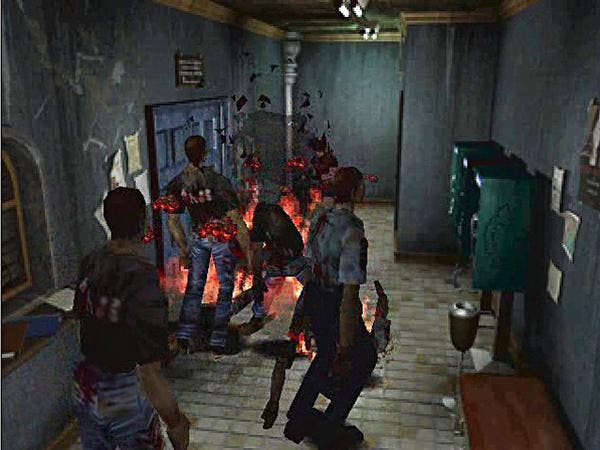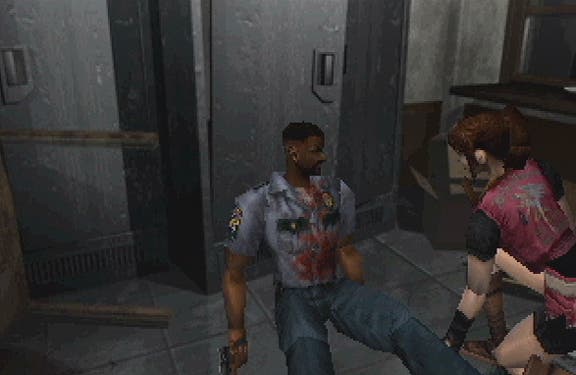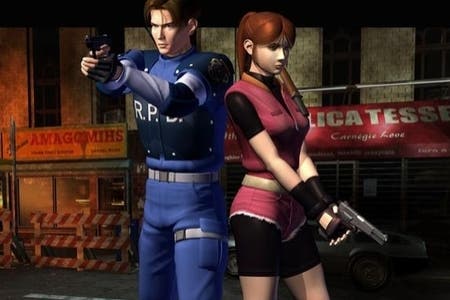Resident Evil 2 retrospective
Still dead good.
It's all about the journey to the police station. There's plenty after that, of course. Monsters. Mutations. The sort of ludicrous plot twists that only Capcom could get away with. But ask me to pick something that defines the Resident Evil series, and it's the opening section of Resident Evil 2 that claws its way to the top of the list. It's the series at its clumsy, infuriating, heart-pounding, nerve-wracking best.
It's easy to forget that the first game in the series, though beloved by many, was a creaky and corny old thing, shambling into action with an endearingly terrible live action cinematic and an awkward opening sequence that feels more like a pastiche of chintzy old haunted house cliches than a terrifying zombie epic. As much as I love the first Resident Evil game, in all its "master of unlocking" cheesy glory, it gets off to an ironically lifeless start.
Dumped in a spooky old mansion and left to poke around, there's no urgency, no impetus to get things moving. The game still delivers some great moments in its first hour - the first encounter with a zombie is iconic stuff, and the dogs still provide a solid jolt - but the hokey setup gives it a safe sense of distance, more baroque Hammer Horror than visceral splatter.

Resident Evil 2 changed that. This was horror brought home, with blood splashing across familiar city streets rather than contained inside a gothic artifice. If the first game was a tribute to a more traditional kind of stage-bound horror, the sequel was a more cinematic and relentless beast. Indeed, George Romero himself, father of the modern zombie movie, was hired to shoot the cosplay flavoured Japanese TV ads for the game and was once in line to helm the big screen adaptation.
Gone is the naff amateur movie intro and in comes what was, for the time, a veritable CG blockbuster. We meet Leon Kennedy, a cop about to start his first day on the job in T-Virus infested Raccoon City, and Claire Redfield, sister of the previous game's now-missing hero, Chris Redfield. Right from the start, there's dramatic imperative and a personal stake in the story about to unfold. Then there's a car chase! A zombie in the back seat! A tanker full of gasoline driven by a man who's just been bitten! A crash! An explosion! And then you're off, controlling either Leon or Claire depending on your opening menu preference.
It's a hell of an opening - one of the first truly cinematic cutscenes of the nascent CD-ROM era of console gaming - and things don't let up once you're in control. Seasoned players tend to race through the first screens, ever conscious of saving ammo, but it's worth going back, taking your time and playing again with fresh eyes.
Consider the uneasy rhythm as it switches from wide open areas to the interior of a bus, open ground giving way to cramped backstreets and alleys making the player wary of both too much space and too little. Look again at the encounter in the gun shop, a scenario clearly devised to replenish your ammo stocks and introduce some of the weaponry you'll later get to wield. Trapped behind the counter as zombies pour in, frantically blasting away at the horde that just won't stop coming, it's as potent a realisation of what makes the undead so unnerving as you're ever likely to play.

By the time you reach the police station itself - the point where the first game effectively began - you're already exhausted, on edge and probably in desperate need of a health spray or green herb. You're engaged, an active participant with a clear and pressing goal. There's quiet ingenuity too in the choice of a police station to get the story rolling. What better way to establish the stakes than to reveal that the very heart of law and order has been torn out and devoured? Nobody is surprised when a spooky old mansion gets overrun with monsters, but when a well-armed police force is lost to the darkness? As Martin Lawrence so wisely said, s*** just got real.
While the game introduced much that was new, Capcom's incremental approach to evolution meant that Resident Evil 2 didn't shake off all the original game's clunky elements. The interminable door openings that tried to mask the chugging loading times. The awkward inventory that made reloading your gun a fumble. "It adds to the horror!" protest the fans. It's not an argument without merit, but let's not pretend this stiffness was a deliberate design feature rather than a technical restriction that just happened to dovetail with the genre.
The script still stinks. "They were parted by an unescapable destiny. This was just the beginning of their worst nightmare," intones the opening line. The fixed camera angles and tank-like movement also remained. At least now you could see the effect of your ordeal reflected in your character as they clutched their side and limped painfully, just one of several useful cosmetic touches introduced for the sequel. Your characters may still have rotated and trotted along like tanks, but they were revealed to be humans who could bleed and suffer, not just rigid mannequins to be steered past obstacles.
Yet it would be a mistake to ignore the huge leaps in narrative quality and gameplay polish that Resident Evil 2 represented. The unlockable bonus missions and different ending criteria. The "zapping system" that allowed Leon and Claire's storylines to overlap and influence each other on different playthroughs remains ingenious - and much imitated - while the use of companion characters was elegantly handled, never dipping into teeth-grinding escort mission nonsense or puncturing the claustrophobic mood with the co-op gunplay that now dominates the series.

None of this was accidental. Infamously, producer Shinji Mikami pulled the plug on the originally planned sequel when it was over halfway complete, as he was concerned that the direction of the game - set in the ruins of the original game's mansion with all new characters - was "dull and boring". It wouldn't be the last time he'd put his foot down - Resident Evil 4 went through multiple versions, one of which became Devil May Cry, before Mikami was satisfied. There was no rebirth as a new franchise for Resident Evil 1.5, as it became known. Instead it vanished into cult obscurity, remembered only in small scraps of development footage.
What we got instead was far more ambitious and far more satisfying. Impatient fans were placated during the extended development time with the largely superfluous "director's cut" of the first game, a tweaked version that existed mostly as a delivery system for the demo version of Resident Evil 2.
That was the demo I played obsessively back in 1997, and that's probably why that breathless introductory chapter remains so vivid in my mind. It represented a promise fulfilled, a game that was willing to step away from the outdated creepshow approach to horror that games still clung to and aspire to the cinematic genre benchmarks put in place by Romero and Raimi.
Lots of people mistakenly think that the Resident Evil games are supposed to be scary. I think the intended tone is one of gnawing anxiety rather than overwhelming fear, that feeling familiar from nightmares where you need to get away from something but you seem to be running on the spot, or the floor becomes thick and gluey. That's still the feeling I get from Resident Evil 2, particularly those early, perfect scenes of urban carnage and frantic escape. That's the bullseye fans still want Capcom to hit.

